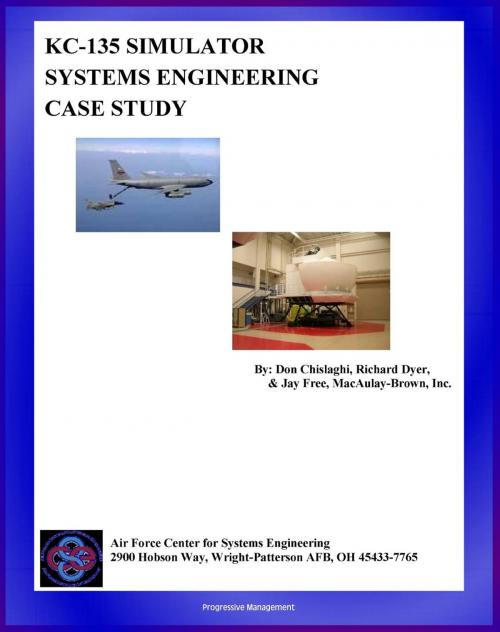KC-135 Simulator Systems Engineering Case Study: Technical Information and Program History
Nonfiction, Science & Nature, Technology, Aeronautics & Astronautics, History, Military, Aviation| Author: | Progressive Management | ISBN: | 9781476101705 |
| Publisher: | Progressive Management | Publication: | July 21, 2012 |
| Imprint: | Smashwords Edition | Language: | English |
| Author: | Progressive Management |
| ISBN: | 9781476101705 |
| Publisher: | Progressive Management |
| Publication: | July 21, 2012 |
| Imprint: | Smashwords Edition |
| Language: | English |
This is one of a series of systems engineering case studies prepared by the Air Force Center for Systems Engineering. This case study analyzes the KC-135, a short-to-medium range tanker aircraft. First flight occurred in August 1956 with Initial Operational Capability (IOC) occurring in June 1957 at Castle AFB, California. A total of 732 aircraft were produced and are operated by Air Education and Training Command (AETC), Air Mobility Command (AMC), Pacific Air Forces (PACAF), United States Air Forces Europe (USAFE), Air national Guard (ANG), and the Air Force Reserve (AFRC). In addition to supporting USAF aircraft the KC-135 fleet also supports the United Sates Navy (USN), United States Marine Corps (USMC), and allied aircraft. The mainstay of the USAF tanker fleet, the long serving KC-135 is similar in size to the commercial Boeing 707 but was designed to military specifications incorporating different structural details and materials. The KC-135 fuel tanks are located in the aircraft's "wet wings" and below the floor in the fuselage.
The study provides a wealth of technical information about the project and its complex history.
The Department of Defense is exponentially increasing the acquisition of joint complex systems that deliver needed capabilities demanded by our warfighter. Systems engineering is the technical and technical management process that focuses explicitly on delivering and sustaining robust, high-quality, affordable solutions. The Air Force leadership has collectively stated the need to mature a sound systems engineering process throughout the Air Force. Gaining an understanding of the past and distilling learning principles that are then shared with others through our formal education and practitioner support are critical to achieving continuous improvement.
Chapter 1. SYSTEMS ENGINEERING PRINCIPLES * 1.1 GENERAL SYSTEMS ENGINEERING PROCESS * 1.1.1 Introduction * 1.1.2 Evolving Systems Engineering Process * 1.1.3 Case Studies * 1.1.4 Framework for Analysis * 1.2 KC-135 ATS MAJOR LEARNING PRINCIPLES AND FRIEDMAN-SAGE MATRIX * Chapter 2. THE KC-135 SYSTEM DESCRIPTION * 2.1 KC-135 AIRCRAFT OVERVIEW * 2.2 KC-135 AIRCREW TRAINING SYSTEM (ATS) OVERVIEW * 2.2.1 KC-135 ATS Mission * 2.2.2 KC-135 A TS Historical Background - Pre 1992 * 2.2.3 Training System Evolution in Capabilities * 2.2.4 KC-135 A TS Key System Capabilities Post 1992 * 2.2.5 KC-135 A TS System Description - Post 1992 * Chapter 3. KC-135 ATS UPGRADE PROGRAM * 3.1 ATS SYSTEM ACQUISITION TEAM * 3.1.1 ATS Stakeholders * 3.1.2 Teaming Relationship * 3.2 KC-135 ATS PERFORMANCE REQUIREMENTS * 3.3 KC-135 ATS SYSTEMS ENGINEERING PROCESS * 3.3.1 Requirements Process * 3.3.2 Risk Management * 3.3.3 Configuration Management * 3.3.4 Design Reviews * 3.3.5 Instructional System Development * 3.3.6 Integrated Logistics/Supportability * 3.4 KC-135 ATS UPGRADE PROGRAM * 3.4.1 Motion System Upgrade * 3.4.2 Computer Rehost Program * 3.4.2.1 Third-Party Contracts * 3.4.3 Pacer CRAG * 3.4.4 Visual Upgrade Effort (VUE) * 3.4.4.1 Context of VUE Program * 3.4.4.2 KC-135 ATS Contractor Role * 3.4.4.3 Lessons Learned * 3.4.5 Aerodynamic Upgrade Enhancement (AUE) * 3.4.5.1 Context of AUE Program * 3.4.5.2 Systems Engineering Issues * 3.4.6 Pacer CRAG Block 40 * 3.4. 7 Distributed Mission Operations * 3.4.8 Instructor Operator Station System * 3.5 KC-135 E/R ATS FOLLOW-ON ACTIVITIES * Chapter 4. SUMMARY * Chapter 5. REFERENCES
This is one of a series of systems engineering case studies prepared by the Air Force Center for Systems Engineering. This case study analyzes the KC-135, a short-to-medium range tanker aircraft. First flight occurred in August 1956 with Initial Operational Capability (IOC) occurring in June 1957 at Castle AFB, California. A total of 732 aircraft were produced and are operated by Air Education and Training Command (AETC), Air Mobility Command (AMC), Pacific Air Forces (PACAF), United States Air Forces Europe (USAFE), Air national Guard (ANG), and the Air Force Reserve (AFRC). In addition to supporting USAF aircraft the KC-135 fleet also supports the United Sates Navy (USN), United States Marine Corps (USMC), and allied aircraft. The mainstay of the USAF tanker fleet, the long serving KC-135 is similar in size to the commercial Boeing 707 but was designed to military specifications incorporating different structural details and materials. The KC-135 fuel tanks are located in the aircraft's "wet wings" and below the floor in the fuselage.
The study provides a wealth of technical information about the project and its complex history.
The Department of Defense is exponentially increasing the acquisition of joint complex systems that deliver needed capabilities demanded by our warfighter. Systems engineering is the technical and technical management process that focuses explicitly on delivering and sustaining robust, high-quality, affordable solutions. The Air Force leadership has collectively stated the need to mature a sound systems engineering process throughout the Air Force. Gaining an understanding of the past and distilling learning principles that are then shared with others through our formal education and practitioner support are critical to achieving continuous improvement.
Chapter 1. SYSTEMS ENGINEERING PRINCIPLES * 1.1 GENERAL SYSTEMS ENGINEERING PROCESS * 1.1.1 Introduction * 1.1.2 Evolving Systems Engineering Process * 1.1.3 Case Studies * 1.1.4 Framework for Analysis * 1.2 KC-135 ATS MAJOR LEARNING PRINCIPLES AND FRIEDMAN-SAGE MATRIX * Chapter 2. THE KC-135 SYSTEM DESCRIPTION * 2.1 KC-135 AIRCRAFT OVERVIEW * 2.2 KC-135 AIRCREW TRAINING SYSTEM (ATS) OVERVIEW * 2.2.1 KC-135 ATS Mission * 2.2.2 KC-135 A TS Historical Background - Pre 1992 * 2.2.3 Training System Evolution in Capabilities * 2.2.4 KC-135 A TS Key System Capabilities Post 1992 * 2.2.5 KC-135 A TS System Description - Post 1992 * Chapter 3. KC-135 ATS UPGRADE PROGRAM * 3.1 ATS SYSTEM ACQUISITION TEAM * 3.1.1 ATS Stakeholders * 3.1.2 Teaming Relationship * 3.2 KC-135 ATS PERFORMANCE REQUIREMENTS * 3.3 KC-135 ATS SYSTEMS ENGINEERING PROCESS * 3.3.1 Requirements Process * 3.3.2 Risk Management * 3.3.3 Configuration Management * 3.3.4 Design Reviews * 3.3.5 Instructional System Development * 3.3.6 Integrated Logistics/Supportability * 3.4 KC-135 ATS UPGRADE PROGRAM * 3.4.1 Motion System Upgrade * 3.4.2 Computer Rehost Program * 3.4.2.1 Third-Party Contracts * 3.4.3 Pacer CRAG * 3.4.4 Visual Upgrade Effort (VUE) * 3.4.4.1 Context of VUE Program * 3.4.4.2 KC-135 ATS Contractor Role * 3.4.4.3 Lessons Learned * 3.4.5 Aerodynamic Upgrade Enhancement (AUE) * 3.4.5.1 Context of AUE Program * 3.4.5.2 Systems Engineering Issues * 3.4.6 Pacer CRAG Block 40 * 3.4. 7 Distributed Mission Operations * 3.4.8 Instructor Operator Station System * 3.5 KC-135 E/R ATS FOLLOW-ON ACTIVITIES * Chapter 4. SUMMARY * Chapter 5. REFERENCES















